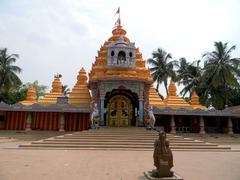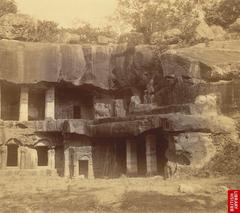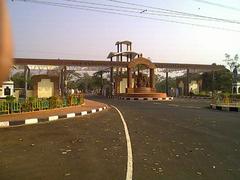Dishisvara Siva Temple Bhubaneswar: Visiting Hours, Tickets, and Travel Guide
Date: 04/07/2025
Introduction
Situated in the heart of Bhubaneswar, the renowned “City of Temples,” the Dishisvara Siva Temple stands as a testament to Odisha’s rich medieval heritage and vibrant Shaiva traditions. Nestled near the sacred Bindusagar Lake within the Kapilesvara temple precinct, the temple offers visitors a profound glimpse into the Kalinga architectural style that flourished between the 7th and 12th centuries CE. Despite its modest scale, the temple’s pidha deul superstructure, intricate stonework, and syncretic motifs reflect a deep confluence of religious and cultural influences, making it both a spiritual and architectural gem.
This comprehensive guide provides an in-depth overview of the temple’s historical context, religious importance, architectural features, practical visiting details—including hours, ticketing, and accessibility—as well as travel tips and nearby attractions. Whether you are a devotee, an architecture enthusiast, or a heritage traveler, this resource equips you to fully experience the serene ambiance and cultural richness of the Dishisvara Siva Temple (Discover Bhubaneswar, Asia361, Odisha State Archaeology).
Table of Contents
- Historical Background and Architectural Heritage
- Religious and Cultural Significance
- Visiting Information
- Architectural Highlights
- Conservation Status and Challenges
- Nearby Attractions
- Summary Table: Dishisvara Siva vs. Other Bhubaneswar Temples
- Frequently Asked Questions (FAQ)
- Visitor Tips and Best Practices
- Conclusion
- Sources
1. Historical Background and Architectural Heritage
Origins and Patronage
The Dishisvara Siva Temple emerged during the golden era of temple building in Bhubaneswar (7th–12th centuries CE), a time when the city—then called Ekamra Kshetra—became a focal point of Shaiva worship under the patronage of the Somavanshi and later Ganga dynasties. These rulers fostered a unique temple-building tradition, culminating in masterpieces such as the Lingaraja Temple, which influenced the stylistic and ritualistic aspects of smaller shrines like Dishisvara Siva (Discover Bhubaneswar, Wikipedia: Lingaraja Temple).
Kalinga Architecture
The temple exemplifies the Kalinga style, characterized by:
- A pidha deul (stepped pyramidal superstructure) over the sanctum
- Curvilinear spires and five-moulded bases (bada)
- Use of locally available laterite and sandstone
- Subtle decorative bands and motifs, often influenced by Hindu, Buddhist, and Jain traditions
Despite its smaller scale compared to grand temples, Dishisvara Siva’s architecture demonstrates the region’s emphasis on proportion, clarity, and symbolic ornamentation (Odisha State Archaeology).
2. Religious and Cultural Significance
Shaiva Worship and Ritual Life
The Dishisvara Siva Temple remains an active site of worship, centering on the Siva lingam, a symbol of cosmic creation and divine union. Daily rituals include abhisheka (ritual bathing), archana (offerings), and aarti (lamp waving). The temple is integral to the city’s religious rhythm, especially during Maha Shivaratri, when thousands gather for night-long vigils and community celebrations (Asia361).
Cultural Role
Dishisvara Siva Temple also functions as a cultural hub, hosting classical dance and music performances, religious education, and seasonal festivals. It plays a vital part in sustaining Odisha’s intangible heritage and social cohesion.
3. Visiting Information
Visiting Hours
- Open daily: 6:00 AM – 9:00 PM
- Best time to visit: Early mornings or during major festivals for a more immersive experience
Entry, Tickets, and Accessibility
- Entry: Free for all visitors; donations welcomed
- Accessibility:
- The temple is accessible by auto-rickshaw, taxi, or bus from Bhubaneswar’s city center and railway station
- Premises are navigable by foot, but pathways may be narrow and uneven; assistance is recommended for differently-abled visitors
Travel Tips
- Wear modest attire and remove footwear before entering the temple
- Respect rituals and avoid loud conversations
- Carry water and sun protection, particularly during summer months
- Photography is not permitted inside the sanctum; exterior photography is generally allowed but be respectful of worshippers
Festivals and Events
- Maha Shivaratri: Major festival with special rituals and community gatherings
- Shravan Month: Additional prayers and fasts
- Local fairs and cultural programs during auspicious lunar dates
4. Architectural Highlights
- Setting: Located within the Kapilesvara precinct, near other significant temples
- Plan: Compact vimana (sanctum), frontal porch, and low platform
- Superstructure: Pidha deul with three receding tiers, five-moulded base, and traditional crown elements (beki, ghanta, amalaka, kalasa, ayudha)
- Materials: Laterite and sandstone
- Ornamentation: Reserved use of decorative bands on door jambs and lintels, with symbolic carvings reflecting regional artistry
5. Conservation Status and Challenges
- Present Condition: The temple is in fair condition following recent renovations by the Odisha State Archaeology department, though ongoing urbanization poses threats such as encroachment and environmental stress.
- Conservation Efforts: Structural stabilization and vegetation removal have been undertaken, but private ownership and urban constraints limit further restoration.
6. Nearby Attractions
Enhance your heritage experience by visiting:
- Lingaraja Temple: The city’s grandest Shaiva shrine
- Mukteswar Temple: Renowned for exquisite carvings and gateway architecture
- Kapilesvara Temple: Major Shiva temple within walking distance
- Radhakrishna Temple: Adjacent shrine dedicated to Lord Krishna
- Bindusagar Lake: Sacred water body central to Bhubaneswar’s temple ecosystem
- Udayagiri and Khandagiri Caves: Ancient Jain monastic sites
7. Summary Table: Dishisvara Siva vs. Other Bhubaneswar Temples
| Feature | Dishisvara Siva Temple | Lingaraj Temple | Mukteswar Temple | Brahmeshwar Temple | Ananta Vasudeva Temple |
|---|---|---|---|---|---|
| Style | Pidha Deul | Rekha Deul | Rekha Deul + Torana | Panchatanaya Plan | Multi-shrine (Vaishnava) |
| Height | 3.68 m | 55 m | ~10 m | ~18 m | ~15 m |
| Material | Laterite, Sandstone | Red Sandstone | Sandstone | Sandstone | Sandstone |
| Decorative Elements | Simple bands | Exquisite carvings | Intricate carvings | Musicians, dancers | Vaishnava iconography |
| Accessibility | Open | Hindus only | Open | Open | Open |
| Preservation | Fair (renovated) | Good | Excellent | Good | Good |
8. Frequently Asked Questions (FAQ)
Q: What are the visiting hours of Dishisvara Siva Temple?
A: Open daily from 6:00 AM to 9:00 PM.
Q: Is there an entry fee?
A: No, entry is free; donations are welcomed.
Q: Are guided tours available?
A: No official guided tours on-site, but local agencies and Odisha Tourism offer broader temple circuit tours.
Q: Is photography allowed?
A: Photography is not permitted inside the sanctum; exterior photography is allowed with respect for worshippers.
Q: Is the temple accessible for differently-abled visitors?
A: Facilities are limited due to narrow, uneven pathways; assistance is recommended.
Q: What festivals are celebrated here?
A: Maha Shivaratri, Shravan month observances, and other Shaiva festivals.
Q: What other sites are nearby?
A: Lingaraja Temple, Mukteswar Temple, Kapilesvara Temple, Radhakrishna Temple, Bindusagar Lake, and Udayagiri/Khandagiri Caves.
9. Visitor Tips and Best Practices
- Visit early or late in the day for a quieter experience and better lighting
- Dress conservatively and follow temple etiquette
- Remove shoes before entering
- Contribute to preservation by being mindful of your impact—avoid touching carvings and do not litter
- During festivals, expect crowds and vibrant religious activity
- For a richer experience, consider joining a guided heritage walk that includes several temples
10. Conclusion
Dishisvara Siva Temple is a hidden gem within Bhubaneswar’s famed temple circuit. Its modest yet evocative architecture, living religious traditions, and role within the city’s historical landscape make it a rewarding destination for spiritual seekers and heritage travelers alike. Despite conservation challenges rooted in urbanization and private ownership, recent renovations have helped stabilize the temple, safeguarding its legacy for future generations. Complement your visit with nearby attractions, and use digital resources like the Audiala app for up-to-date information, guided tours, and festival alerts.
By respecting traditions, supporting local conservation, and immersing yourself in the city’s temple ecosystem, your exploration of Dishisvara Siva Temple will be both meaningful and memorable.
11. Sources
Images: [Insert high-quality images of the Dishisvara Siva Temple exterior and surroundings here with alt text such as “Dishisvara Siva Temple Bhubaneswar facade” and “Kalingan architectural details at Dishisvara Siva Temple”]
Interactive Map: [Embed interactive map showing the location of Dishisvara Siva Temple in relation to other historical sites in Bhubaneswar]
Related Articles:








